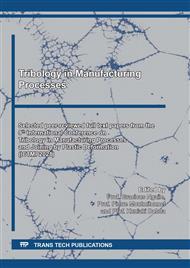p.3
p.13
p.21
p.33
p.39
p.45
p.51
p.59
New Developments in Phosphate Free Lubrication
Abstract:
The classical tribological systems which are used in cold forming are still based on zinc phosphate as a separation layer and soap as a lubricant. Due to the globalization more and more processes are required following a globalized environmental protection and chemical registration concept. Therefore, the search for resource-efficient and environmentally friendly pretreatment concepts in cold forming are essential to fulfill these demands. One possible solution can be found in the phosphate free cold forming processes. Globally seen, there are different development routes to gain phosphate free tribological systems. On one hand, lubricants have been developed which are working without a conversion layer but leading to less forming performance which is often unacceptable out of profitability. On the other hand, there is the possibility to use a zinc phosphate free conversion coating layer to realize a phosphate free tribological system, without leaving the common system consisting out of a separation layer with a lubricant on top through remaining the same performance known from common systems. Beside this, it is discussed how a further development concept of this system leads to easier and shorter processes introducing a reactive lubricant concept. With the help of the reactive lubricant it is possible to apply a separation layer and a lubricant in one treatment step and obtain a phosphate free separation layer with a self-assembled lubricant on top. This system enables to realize a phosphate-free cold-forming process without changing the application of the lubricant and the forming process.
Info:
Periodical:
Pages:
3-11
Citation:
Online since:
February 2022
Authors:
Keywords:
Price:
Сopyright:
© 2022 Trans Tech Publications Ltd. All Rights Reserved
Share:
Citation:


